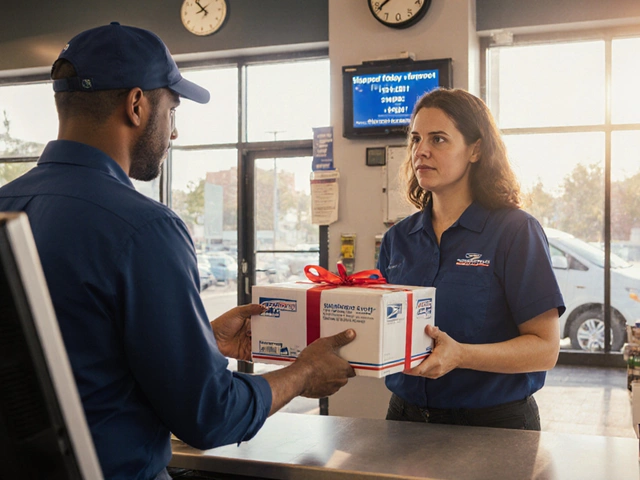Ever wondered if there's a difference between e-commerce and online shopping? You're not alone. It's easy to assume they're interchangeable, but they actually refer to different things in the world of digital sales.
To break it down simply, e-commerce is like the entire ecosystem of buying and selling goods and services over the internet. It covers everything from the marketing, supply chain, and payment processes to the logistics involved in getting products from point A to point B. Think of it as the big picture of internet-based trade.
On the other hand, online shopping is more about your personal experience browsing and buying stuff through websites or apps. It's what you do when you're adding those quirky socks or the latest smartwatch to your cart from the comfort of your couch.
Understanding these differences isn't just about getting your terminology right. It's also about realizing how e-commerce as a whole functions, which is key for anyone involved in digital business or just for those of us who love a good online shopping spree.
- Defining E-commerce and Online Shopping
- Components of E-commerce
- The Role of Online Shopping in E-commerce
- E-commerce Logistics Explained
- Case Studies: Real-world Examples
- Tips for Optimizing Online Shopping Experience
Defining E-commerce and Online Shopping
Let's cut through the confusion around e-commerce and online shopping. Although they're closely related, they mean different things in the digital world. So, what's the real scoop?
Understanding E-commerce
E-commerce is like the entire online selling machine. It includes every aspect of buying and selling goods and services over the internet. This **big umbrella** covers everything from digital marketing and customer service to payment processing and logistics. It's basically the whole shebang of online commercial activities.
Imagine you're running an online store. E-commerce involves managing your website, payment systems, and order fulfillment processes. That means handling inventory, shipping, and even managing returns. Everything that gets your product from the screen to your customer's door fits under the e-commerce category.
The Scope of Online Shopping
Now, online shopping is a piece of the e-commerce pie – a big piece, yes, but still a piece. It's all about the buying experience for users. When you open an app or visit a website to buy those funky sneakers or a cool gadget, you're diving into the world of online shopping.
Basically, online shopping revolves around the platforms and interfaces users interact with. It's about making the purchase as quick and pleasant as possible while keeping customers informed and happy throughout their journey.
A Quick Comparison
- E-commerce is the whole digital commerce process, including marketing, supply chain, and logistics.
- Online shopping is specifically about purchasing products or services over the internet.
Fun fact: According to recent data, global e-commerce sales hit around $5 trillion last year. That's huge! Online shopping is the driving force behind this massive number, illustrating the important role it plays within e-commerce.
Components of E-commerce
So, let's talk about the moving parts of e-commerce. It's not just about putting products online and waiting for buyers. There's a whole lot going on behind the scenes.
1. Online Storefront
First things first, the online storefront. This is the website or app where customers browse and buy. It's like a digital shop front, complete with product catalogs, user reviews, and a secure checkout process. Your website needs to be user-friendly and attractive to keep people coming back.
2. Payment Processing
Next up is payment processing. An essential piece of the e-commerce puzzle! Customers need safe and simple ways to pay for their purchases, and this usually means integrating payment gateways like PayPal, Stripe, or traditional credit card processors. Keeping transactions secure builds trust and encourages repeat business.
3. Inventory Management
Inventory management is all about keeping track of your stock. The system should automatically update as orders come in and are shipped out. It's key to avoid those dreaded out-of-stock messages that can frustrate customers.
4. Order Fulfillment and Shipping
Shipping and fulfillment might not be glamorous, but they're crucial. After all, once somebody clicks 'buy,' the order has to get to them! Efficient shipping means happy customers. Consider automating some of these tasks with an order management system to speed things up.
| Year | Global E-commerce Sales (in billions) |
|---|---|
| 2020 | 3,914 |
| 2025 (est.) | 7,391 |
5. Marketing and Customer Relationship Management (CRM)
Finally, marketing and CRM are all about keeping the conversation going with customers. Whether through email newsletters, targeted ads, or chatbots, maintaining a good relationship with customers can help boost repeat business and grow your online shopping numbers.
Strong e-commerce platforms tie all these components together, making it easier to run the show. When they're syncing well, operations run smoothly and customer satisfaction stays high.
The Role of Online Shopping in E-commerce
Online shopping isn't just clicking and adding to a cart—it's a fundamental piece of the larger e-commerce puzzle. It’s the consumer-facing side where direct interactions between buyers and products happen.
Connecting Consumers and Retailers
Think of online shopping as the bridge connecting people to their desired products, sans the physical store. Retailers use online platforms to showcase their goods, offering convenience and variety that traditional brick-and-mortar stores might struggle to match. Customers appreciate browsing a wide range of options without leaving their homes.
User Experience is Key
The success of online shopping largely depends on the user interface and experience. Platforms need to be intuitive, easy to navigate, and quick to load. A smooth, seamless process from browsing to checkout encourages repeat visits and builds brand loyalty.
Driving E-commerce Innovations
Online shopping has pushed e-commerce innovations, like personalized recommendations and AI-driven customer service. Features like virtual try-ons and augmented reality previews of products are becoming popular too.
| Feature | Benefit |
|---|---|
| Personalized Recommendations | Higher customer satisfaction |
| AI Customer Service | Quick issue resolution |
Global Reach and Accessibility
Another great thing about online shopping? Its ability to break down geographical barriers. Customers from anywhere in the world can access products from international sellers, making it invaluable for expanding market reach.
This connection between online shopping and e-commerce highlights how integral shopping platforms are not just for sales but for reshaping the global retail landscape itself.

E-commerce Logistics Explained
When we talk about e-commerce logistics, we're diving into the nitty-gritty of how online purchases get from the warehouse to your doorstep. It's kind of like the backstage crew that ensures everything runs smoothly in the theater of online shopping.
The process starts with inventory management, which is all about knowing what stock is available and where it needs to go. Companies use tech-savvy systems to keep track, making sure they're ready to ship products the moment you hit 'buy.'
Warehousing and Fulfillment
Next up, we have warehousing, which is where products sit until they're packed and shipped. Some big players like Amazon have sprawling distribution centers, while smaller businesses might opt for third-party services to handle storage and fulfillment.
In terms of fulfillment, it's all about speed and accuracy. The goal is to get your order packed and on its way as quickly as possible, ideally without any hiccups. Think about all those 'order now, get it tomorrow' deals—you can thank efficient logistics for that perk.
Shipping and Delivery
Once packed, items are shipped using different transportation methods, whether by road, air, or sea. Companies might strike deals with carriers like FedEx or UPS to get the best rates and fastest delivery times.
There's also the last-mile delivery, which is the final leg of the journey. This part can get tricky, especially in crowded cities where traffic and security can delay things. Online shopping companies are constantly coming up with innovative solutions, like using drones or locker pickups, to make this phase smoother.
Returns Management
Let's not forget returns management—an equally important part of e-commerce logistics. Companies need to make returns easy and hassle-free for customers, because a bad return experience can seriously damage a brand's reputation.
Cost Breakdown
Here's a basic breakdown of logistics costs:
| Logistics Component | Approx. % of Total Cost |
|---|---|
| Transportation | 40% |
| Warehousing | 30% |
| Inventory Management | 20% |
| Packaging | 10% |
Understanding these details helps businesses tweak their logistics strategies to save money and boost speed, giving them an edge in the competitive world of e-commerce.
Case Studies: Real-world Examples
Looking at how major players use e-commerce and online shopping can give us real insights. Let's check out a few examples that illustrate their roles.
Amazon: The E-commerce Giant
Everyone knows Amazon, right? But what makes it such a big deal in the e-commerce space? It's not just about letting you buy practically anything online. Amazon's strength lies in its logistics network. From distribution centers popping up everywhere to amazing delivery speeds, Amazon redefined what it means to shop online.
Aside from just selling stuff, it supports vast third-party vendors, handling shipping, returns, and even customer service. This comprehensive process shows e-commerce at its finest, going way beyond basic online shopping.
Etsy: Crafting a Marketplace
Etsy's platform focuses on handmade and vintage items, carving a niche in the online shopping world. It's about connecting artisans with buyers seeking unique goods. While Etsy hosts countless small businesses, it also provides an easy interface for sellers to manage their e-stores. This highlights the personalized aspect of online shopping, which contrasts with Amazon's huge catalog.
What's neat is Etsy supports sellers with tools for managing their shops, showing how segmented, specialized platforms can be successful in e-commerce.
Case in Numbers: E-commerce and Online Shopping
| Platform | Active Buyers (2024) | Revenue (2024) |
|---|---|---|
| Amazon | 300 million | $500 billion |
| Etsy | 96 million | $2.5 billion |
These figures emphasize how diverse the experiences of e-commerce are, with both massive general platforms and specialized ones thriving. It shows that both scale and specialization can be winning strategies.
So, why should this matter to you? Understanding these dynamics helps in grasping how businesses cater to consumer preferences and in making smarter decisions whether you're shopping or selling online.
Tips for Optimizing Online Shopping Experience
If you want to make the most out of your online shopping escapades, I've got some handy tips for you. It's not just about swiping and tapping; it's about being smart and savvy with your digital purchases.
1. Utilize Browser Extensions
Ever heard of Honey or Rakuten? These browser extensions can find and apply the best discounts for your purchases, or even give you cashback. They make sure you don't miss a deal, turning your typical shopping session into a treasure hunt!
2. Timing is Everything
Prices can vary wildly depending on the time of year, or even the day of the week. Shopping during sales events like Black Friday or mid-season sales can result in huge savings. Keep an eye on trends and plan your big buys accordingly.
3. Read Reviews and Compare
Before hitting that 'Buy Now' button, make sure to read customer reviews. They often have the real scoop on product quality. Also, compare prices across different e-commerce sites to get the best deal.
4. Secure Payment Methods
Protect your financial information by using secure payment methods. Services like PayPal add an extra layer of security rather than entering your credit card details directly on every site.
5. Leverage E-commerce Apps
Many e-commerce stores have apps that offer exclusive deals and extra features, like order tracking. Downloading these can make the whole experience smoother and sometimes cheaper.
| Method | Improvement |
|---|---|
| Price Comparison | Around 20% savings |
| Using Coupons | Up to 30% off |
| Shopping Apps | Easy access to deals |
6. Keep a Wishlist
Most online platforms let you keep a wishlist. Use it! It helps with spontaneous spends; if something from your wishlist is on sale, you'll know. Plus, tracking items you’re interested in is super helpful during big sale events.
And there you have it, a few ways to hack your online shopping experience. Keep these tricks handy, and you’ll not only find what you want but also save money along the way. Now, happy shopping!





